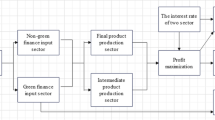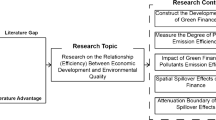Abstract
The objective of this study is to attempt to assess the effect of green finance in reducing carbon emissions in China, analyze the transformative role of policy impact in the development of green finance markets, and investigate the impact mechanisms of how green finance affects carbon dioxide emissions. Our time frame from 2007 to 2018 is selected for the empirical study by integrating the availability of data due to the scarcity of relevant statistics in the early days of green finance. Location of this study is in China where 30 provinces are included, excluding Tibet due to severe data shortage. As for methodology, we construct a green finance evaluation index system containing five indicators by entropy weight method, choose dynamic spatial Durbin model (DSDM) for empirical research, and perform mechanism analysis of restructuring industry and greening technology as intermediary channel. Our findings demonstrate that green finance in China does significantly reduce carbon emissions, and its spatial spillover effect and long-term effect are also verified. Furthermore, green finance tends to reduce CO2 emissions through restructuring industry and greening technology. Correspondingly, policy implications are recommended. First, improving green financial market and strengthening information disclosure of green financial market are crucial to facilitate green finance development. Local governments formulate carbon emission reduction strategies focusing on space by joint conference or coordination mechanism like river head system. Lastly, a mechanism should be developed to strengthen the transformation of industrial structure and to promote greening technology.


Similar content being viewed by others
Data availability
The datasets used and/or analyzed during the current study are available from the corresponding author on reasonable request.
References
Acemoglu D, Aghion P, Bursztyn L, Hemous D (2012) The environment and directed technical change. Am Econ Rev 102(1):131–166
Anser MK, Alharthi M, Aziz B, Wasim S (2020) Impact of urbanization, economic growth, and population size on residential carbon emissions in the SAARC countries. Clean Technol Environ Policy 22(4):923–936
Bai J, Chen Z, Yan X, Zhang Y (2022) Research on the impact of green finance on carbon emissions: evidence from China. Economic Research-Ekonomska Istraživanja 1–20. https://doi.org/10.1080/1331677X.2022.2054455
Bretschger L, Pattakou A (2019) As bad as it gets: how climate damage functions affect growth and the social cost of carbon. Environ Resource Econ 72:5–26
Brock WA, Taylor MS (2010) The green Solow model. J Econ Growth 15(2):127–153
Charfeddine L, Khediri KB (2016) Financial development and environmental quality in UAE: cointegration with structural breaks. Renew Sustain Energy Rev 55:1322–1335
Clark R, Reed J, Sunderland T (2018) Bridging funding gaps for climate and sustainable development: pitfalls, progress and potential of private finance. Land Use Policy 71:335–346
Dinda S (2004) Environmental Kuznets curve hypothesis: a survey. Ecol Econ 49(4):431–455
Dogan E, Seker F (2016) The influence of real output, renewable and non-renewable energy, trade and financial development on carbon emissions in the top renewable energy countries. Renew Sustain Energy Rev 60:1074–1085
Elhorst JP (2014) Spatial panel data models. In: Spatial econometrics. SpringerBriefs in Regional Science. Springer, Berlin, Heidelberg. https://doi.org/10.1007/978-3-642-40340-8_3
Fu H, Li G, Zhu T (2021) Carbon emissions in China's manufacturing industry: industry differences and decomposition of driving factors. Reform (05):38–52
Yaping Fu, Zhengqin P (2020) Green financial development, R&D investment and regional economic growth: empirical evidence based on provincial panel threshold model. Stat Decision 21:5
Gao L, Tian Q, Meng F (2022) The impact of green finance on industrial reasonability in China: empirical research based on the spatial panel Durbin model. Environ Sci Pollut Res. https://doi.org/10.1007/s11356-022-18732-y
He Y, Fu F, Liao N (2021) Exploring the path of carbon emissions reduction in China’s industrial sector through energy efficiency enhancement induced by R&D investment. Energy 225:120208
Höhne N, Khosla S, Fekete H, Gilbert A (2012) Mapping of green finance delivered by IDFC members in 2011. Ecofys, Cologne. Available from: http://www.idfc.org/Downloads/Publications/01_green_finance_mappings/IDFC_Green_Finance_Mapping_Report_2012_14-06-12.pdf
Jeucken M (2001) Sustainable finance and banking. UK, Earthscan Publications Ltd, London
Khan MA, Riaz H, Ahmed M, Saeed A (2022) Does green finance really deliver what is expected? An Empirical Perspective Borsa Istanbul Review 22(3):586–593
Kotchen MJ (2018) Which social cost of carbon? A theoretical perspective. J Assoc Environ Resour Econ 5(3):673–694
Kublicki NM (1993) Green finance: problems and solutions concerning alternative environmental debt exchanges. Vt l Rev 18:313
Kumari RL (2012) Enhancing SMEs access to green finance. International Journal of Marketing, Financial Services & Management Research 1(7):22–35
Li XX, Xia G (2014) China green finance report. 2014. China Finance Press
Li CX, Wang XY (2021) A study on the policy effects of green finance on environmental pollution. J Hebei Univ Environ Eng 02:1–5
Liu HJ, Shi Y, Lei MY (2019) Regional disparity of carbon emissions and its structural decomposition in China from the perspective of carbon sources. China Popul Resour Environ 29(08):87–93
Liu JK, Xiao YY (2022) Environmental protection tax and green innovation in China: leverage or crowding out effect? Econ Res J 01:72–88
Liu Z, Guan D, Wei W, Davis SJ, Ciais P, Bai J, ..., He K (2015) Reduced carbon emission estimates from fossil fuel combustion and cement production in China. Nature 524(7565):335-338
Long R, Gan X, Chen H, Wang J, Li Q (2020) Spatial econometric analysis of foreign direct investment and carbon productivity in China: two-tier moderating roles of industrialization development. Resour Conserv Recycl 155:104677
Lucas R (1988) On the mechanics of economic development. J Monet Econ 22(1):3–42
Lv Z, Li S (2021) How financial development affects CO2 emissions: a spatial econometric analysis. J Environ Manage 277:111397
Lyu L, Khan I, Zakari A (2022) A study of energy investment and environmental sustainability nexus in China: a bootstrap replications analysis. Environ Sci Pollut Res 29(6):8464–8472
Meo MS, Abd Karim MZ (2022) The role of green finance in reducing CO2 emissions: an empirical analysis. Borsa Istanbul Rev 22(1):169–178
Nordhaus WD (1994) Managing the global commons: the economics of climate change. MIT press, Cambridge, MA
Salahuddin M, Gow J, Ozturk I (2015) Is the long-run relationship between economic growth, electricity consumption, carbon dioxide emissions and financial development in Gulf Cooperation Council Countries robust? Renew Sustain Energy Rev 51:317–326
Salazar J (1998) Environmental finance: linking two world. In a Workshop on financial innovations for biodiversity Bratislava. Vol 1, pp 2–18
Shan Y, Liu J, Liu Z, Xu X, Shao S, Wang P, Guan D (2016) New provincial CO2 emission inventories in China based on apparent energy consumption data and updated emission factors. Appl Energy 184:742–750
Shao G, Lin Y (2022) An empirical study on the impact of environmental regulation and corporate environmental behavior on carbon emissions in the context of carbon neutrality. J Ocean Univ China (social Sciences) 02:63–74
Singhania M, Saini N (2021) Demystifying pollution haven hypothesis: role of FDI. J Bus Res 123:516–528
Tamazian A, Chousa JP, Vadlamannati KC (2009) Does higher economic and financial development lead to environmental degradation: evidence from BRIC countries. Energy Policy 37(1):246–253
Tawiah VK, Zakari A, Khan I (2021) The environmental footprint of China-Africa engagement: an analysis of the effect of China-Africa partnership on carbon emissions. Sci Total Environ 756:143603
Tawiah V, Zakari A, Li G, Kyiu A (2022) Blockchain technology and environmental efficiency: evidence from US-listed firms. Bus Strateg Environ 1–12. https://doi.org/10.1002/bse.3030
Tobler WR (1970) A computer movie simulating urban growth in the Detroit region. Econ Geogr 46(sup1):234–240
Uzawa H (1965) Optimum technical change in an aggregative model of economic growth. Int Econ Rev 6(1):18–31
Vasile P, Holt AG (2014) The strategy of financing the environmental projects through the national action plan for environment in Romania. Ann Econ Series 3:70–73
Wang G, Li G (2020) Research on carbon emission reduction effect of ecological province construction. Acta Geograph Sin (11):2431–2442
Wang B, Sun Y, Wang Z (2018) Agglomeration effect of CO2 emissions and emissions reduction effect of technology: a spatial econometric perspective based on China’s province-level data. J Clean Prod 204:96–106
Wang B, Yu M, Zhu Y, Bao P (2021a) Unveiling the driving factors of carbon emissions from industrial resource allocation in China: a spatial econometric perspective. Energy Policy 158:112557
Wang F, Wang R, He Z (2021b) The impact of environmental pollution and green finance on the high-quality development of energy based on spatial Dubin model. Resour Policy 74:102451
Wang X, Wang Q (2021) Research on the impact of green finance on the upgrading of China’s regional industrial structure from the perspective of sustainable development. Resour Policy 74:102436
Wen S, Shi H, Guo J (2022) Green finance and economic growth quality: construction and empirical testing of a general equilibrium model with resource and environmental constraints. Chinese J Manag Sci 03:55–65
Wu D, Wang Y, Qian W (2020) Efficiency evaluation and dynamic evolution of China’s regional green economy: a method based on the Super-PEBM model and DEA window analysis. J Clean Prod 264:121630
Wu L, Sun L, Qi P, Ren X, Sun X (2021) Energy endowment, industrial structure upgrading, and CO2 emissions in China: revisiting resource curse in the context of carbon emissions. Resour Policy 74:102329
Xiong Q, Sun D (2022) Influence analysis of green finance development impact on carbon emissions: an exploratory study based on fsQCA. Environ Sci Pollut Res. https://doi.org/10.1007/s11356-021-18351-z
Yang P, Ma J (2017) Comparison of green finance development models between China and Britain. China Finance 22:62–64
Ye T, Xiang X, Ge X, Yang K (2022) Research on green finance and green development based eco-efficiency and spatial econometric analysis. Sustainability 14(5):2825
Zakari A, Khan I (2021) The introduction of green finance: a curse or a benefit to environmental sustainability? Energy Res Lett 3(Early View):29977
Zakari A, Li G, Khan I, Jindal A, Tawiah V, Alvarado R (2022) Are abundant energy resources and Chinese business a solution to environmental prosperity in Africa? Energy Policy 163:112829
Zhao J, Jiang Q, Dong X, Dong K, Jiang H (2022) How does industrial structure adjustment reduce CO2 emissions? Spatial and mediation effects analysis for China. Energy Econ 105:105704
Author information
Authors and Affiliations
Contributions
Conceptualization: Ziqiang Lin, Xianchun Liao.
Data curation: Ziqiang Lin.
Formal analysis and investigation: Ziqiang Lin, Xianchun Liao.
Methodology: Ziqiang Lin, Xianchun Liao.
Visualization: Ziqiang Lin.
Writing-original draft preparation: Ziqiang Lin.
Validation: Ziqiang Lin, Xianchun Liao.
Modification suggestions: Xianchun Liao, Yuexia Yang.
Language polish: Yuexia Yang, Xianchun Liao.
Writing-review and editing: Xianchun Liao.
All authors read and approved the final manuscript.
Corresponding author
Ethics declarations
Ethics approval and consent to participate
Not applicable.
Consent for publication
Not applicable.
Competing interests
The authors declare no competing interests.
Additional information
Responsible Editor: Nicholas Apergis
Publisher's note
Springer Nature remains neutral with regard to jurisdictional claims in published maps and institutional affiliations.
Rights and permissions
Springer Nature or its licensor holds exclusive rights to this article under a publishing agreement with the author(s) or other rightsholder(s); author self-archiving of the accepted manuscript version of this article is solely governed by the terms of such publishing agreement and applicable law.
About this article
Cite this article
Lin, Z., Liao, X. & Yang, Y. China’s experience in developing green finance to reduce carbon emissions: from spatial econometric model evidence. Environ Sci Pollut Res 30, 15531–15547 (2023). https://doi.org/10.1007/s11356-022-23246-8
Received:
Accepted:
Published:
Issue Date:
DOI: https://doi.org/10.1007/s11356-022-23246-8




